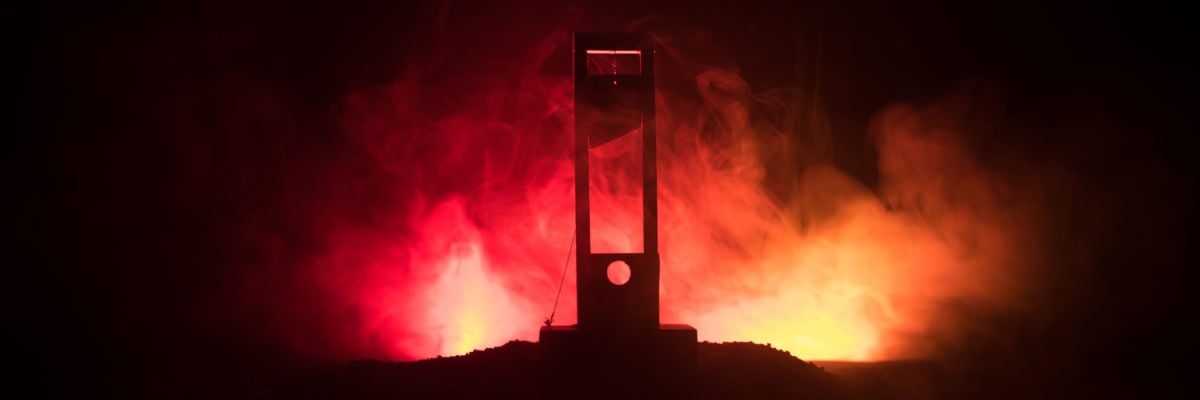
Today we celebrate the feast day of Blessed Guillaume Repin, a priest and martyr who was executed in 1793 by order of a committee of the French revolutionary government. Repin was linked to the counter-revolutionary “Catholic and Royal Army” in the western French department of the Vendée, which in 1793 launched a brief, heroic insurgency against a Jacobin regime attempting to destroy the Catholic Church in France. Though little known today, the Vendée uprising represents an inspiring (and instructive) story, relevant for 2023, of Catholic triumph against secular regimes.
One of the acts of the anti-Catholic French revolutionary government was the Civil Constitution of the Clergy, which required all clerics to pledge allegiance to the Constitution, subordinating the clergy to the French government. It was deeply unpopular in the devoutly Catholic Vendée region. When the revolutionary Republican government enacted a nationwide conscription in March 1793, the residents of the Vendée took up arms, demanding the reopening of their parish churches, many of which had been seized by the government.
Between March and December 1793, thousands of Catholic royalist forces engaged in a number of pitched battles—as well as constant guerrilla warfare—against the forces of the Republic. For a time, the Catholics, who wore a patch dedicated to the Sacred Heart of Jesus, won a number of victories. Yet numbers and munitions were not on their side. Defeats in the fall of 1793 culminated in the December 23, 1793 Battle of Savenay, at which a Republican force of approximately 18,000 decisively defeated the Catholic and Royal Army of about 6,000.
After the battle, Republican General François Joseph Westermann is reported to have written to his superiors: “The Vendée is no more. . . . According to your orders, I have trampled their children beneath our horses’ feet; I have massacred their women, so they will no longer give birth to brigands. I do not have a single prisoner to reproach me. I have exterminated them all.”
The authenticity of Westermann’s letter is disputed, but it’s not hard to find examples elsewhere of atrocities committed by the French Republicans. Between November 1793 and February 1794 in the city of Nantes, suspected royalist sympathizers, as well as Catholic priests and nuns, were systematically drowned in the river Loire. About 4,000 people, including many women and children, were killed. More than 2,000 more victims were killed by firing squad at a quarry near Nantes. It is estimated that between January and May 1794, as many as 50,000 civilians of the Vendée were massacred.
One of those civilians was Father Guillaume Repin. The French priest had been arrested by Republican authorities in 1792 but freed by Royalists a year later. Because of his old age, he was unable to flee far, and was captured again a year later. He was sentenced to the guillotine and executed on January 2, 1794. He was eighty-three years old.
Why would a powerful political regime feel so threatened by an elderly priest, unable even to evade his own captors, that they felt compelled to execute him? The answer is found in how totalizing the French revolutionaries’ ambitions were to destroy Catholicism in France, the “eldest daughter of the Church.” The Jacobins sought to destroy all objects of Catholic veneration, including icons, statues, and crosses. It confiscated Church property. It subverted the Church’s centrality to the family by taking control over birth, death, and marriage registers. It created a new, secular calendar and civic cults based on “reason.” It wanted, in sum, a Catholicism so weakened and neutralized it could be easily dominated by the state.
This “Reign of Terror” did eventually subside. Many of the Jacobins were killed, Napoleon assumed power, and the country even today remains nominally Catholic. But the damage was done. Thousands of French churches never reopened. In little over a decade, 20,000 priests abdicated their ordinations under threat of death; another 30,000 were forced to leave a country of about 28 million people. (The United States, a country that has more than 60 million Catholics, has less than 40,000 priests today.) Only fifteen percent of Frenchmen today are practicing Catholics, and under five percent attend Mass weekly.
It could be said that we Americans today suffer the results of that secularizing effort that began 230 years ago. Today, many prominent politicians, while proudly claiming their Catholic identity, place their allegiance to their party and its policies over Church doctrine. About thirty million people, or ten percent of the population, are ex-Catholics. In the last fifty years, the number of Catholic priests in America has decreased by 60 percent. In recent decades, hundreds of churches have closed, a trend accelerated by the COVID-19 pandemic.
The enemies of the Church have realized that you don’t need to imprison or kill clergy and devout laymen to render Catholicism harmless (though the late Chicago cardinal Francis George warned that his successors might in time suffer such fates). Just as effective is to weaken its public influence—say, by closing Catholic adoption agencies or attacking Catholic hospitals. Alternatively, the institutions of secular power foreground so-called Catholic voices who question or reject Catholic teaching, muddying the Church’s witness and persuading many Catholics that autonomy and freedom, those pre-eminent goods of liberalism, are what matters most.
The result is more or less the same as what happened in France. The Church’s influence over culture is a shadow of what it was two generations ago. Practicing Catholics realize that many of their public schools and libraries, which promote radical sexual ideology, are not safe places for their children. “Pride Month” increasingly rivals Christmas as the most important event in our civic calendar—and even Christmas is not safe from drag queens. It feels as though we are strangers in a strange land, as it did for pious Catholics in the Vendée many years ago.
And yet there is hope. Almost fifty years to the day after Blessed Guillaume Repin was martyred, a little girl was born to a miller and his laundress wife in southwestern France. They named her Bernadette. Fourteen years later, the girl would see a vision of the Virgin Mary that would result in the conversions and healing of thousands and the confirmation of a dogma: the Immaculate Conception, promulgated in 1854. Five million pilgrims visit Lourdes, the site of that Marian apparition, every year.
The many miracles at Lourdes, and the horrors of the war in the Vendée that preceded them, are a necessary reminder as we begin a new year: as much as Christ’s enemies may try to undermine and destroy his Church, he will continue to build his kingdom, often from its own ruins. The continued spiritual power of an elderly cleric and a little peasant girl in France prove the point.



